30 Aug A Complete Travel Guide to Huaraz: Peru’s Hiking Capital
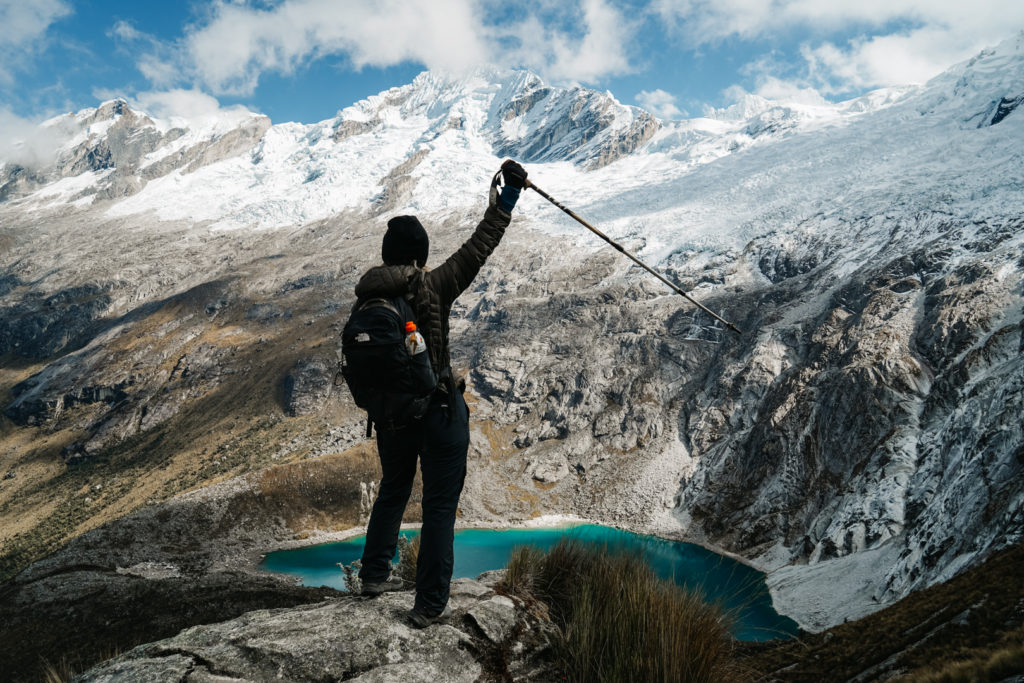
If you’ve stumbled upon this blog post it must be that you’ve discovered some of the best hiking in Peru is not solely in Cusco. While the treks to Machu Picchu are stunning, some of the most impressive views of this popular backpacker destination can actually be found in Huaraz, otherwise known as Peru’s hiking capital.
Sitting in a valley outside the Cordillera Blanca Mountain Range, Huaraz is an outdoor enthusiast’s paradise and a hub for some of the most beautiful trails in the world through the Andes Mountains. Tourists from Huaraz can choose from a number of activities including day trips to glaciers, ice-climbing summits, hiking to gatorade blue lakes, or even tackling multi-day treks such as Santa Cruz and the famed Huayhuash.
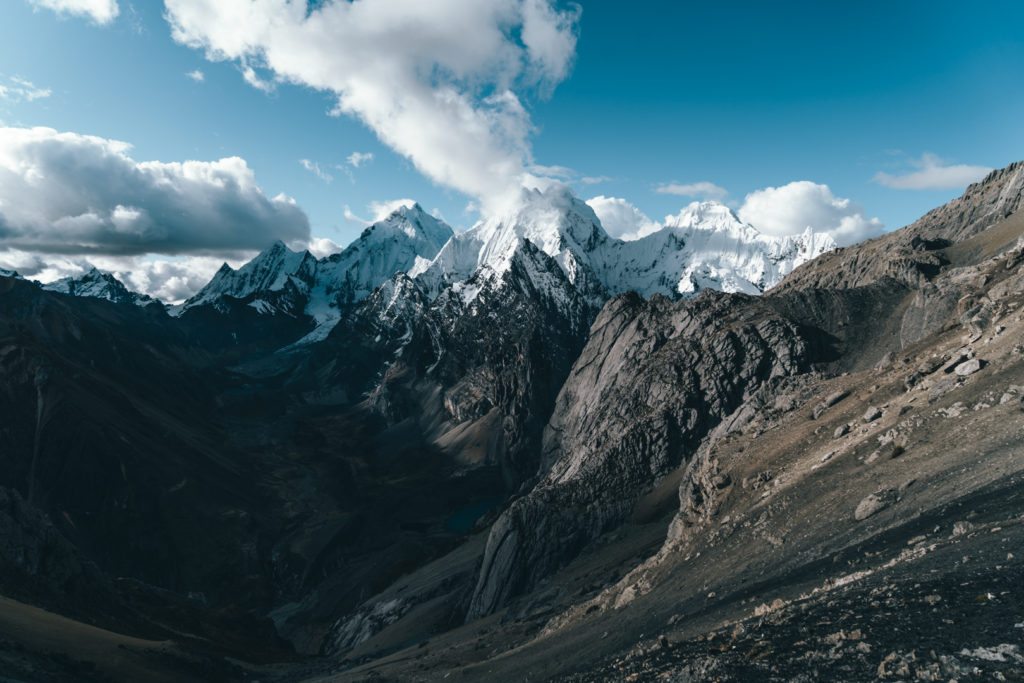
By the time I visited Huaraz, photos of bright blue lakes and icy glaciers had been saved in my bucket list folders for years, so it felt surreal to finally be there. In total, I spent about a month in Huaraz taking day trips to places like Laguna 69 and going on longer treks like Santa Cruz and Huayhuash. My time in Huaraz was nothing short of incredible and a place where I witnessed some of the most mind-blowing natural scenery and pushed my body to limits I didn’t even know it could go.
If you’re ready for a bit of adventure, here’s everything you need to know to visit Huaraz, Peru:
What's in this post
Click to skip ahead
*This post includes affiliate links and I may receive a small commission at no additional cost to you. By using my links you’re merely supporting what I love to do: write this blog! I only recommend products/companies that I use myself. Thank you for your support 🙂

WHERE IS HUARAZ?
Huaraz is about 400 km (250 miles) north of Lima sitting at about 3,052 m, or 10,013 ft (pretty high up there!). It’s a small city in a valley surrounded by snow-capped Andean mountains and is the main hub to depart from when exploring the Cordillera Blanca and Cordillera Huayhuash Mountains.
GETTING TO HUARAZ
Huaraz doesn’t have an airport so the only way to get there is to drive yourself or take a bus (the most popular and most practical option for most).
How to get to Huaraz from Lima
To get to Huaraz from Lima, you can take an 8-9 hour bus. It’s possible to depart during the day, but the most popular option is to book a night bus so you can sleep (hopefully) the entirety of the trip.
There are a number of bus companies to book with such as Movil, Civa and Cruz del Sur. For easy booking and comparing prices, you can search and book your ticket on Busbud.
When choosing your ticket, note there are different seating options based on seat reclining degrees and other factors. For example, cheaper seats only recline 140 degrees whereas premier seats recline 180 degrees, similar to a bed for better sleep – a game changer on those overnight trips.
Ticket prices are typically around S/100 ($25 USD) depending on when you book and which seat you choose.
After arriving in Huaraz by bus, you can walk or take a taxi to your accommodation.
If traveling the other way from Huaraz to Lima, the process is the same.
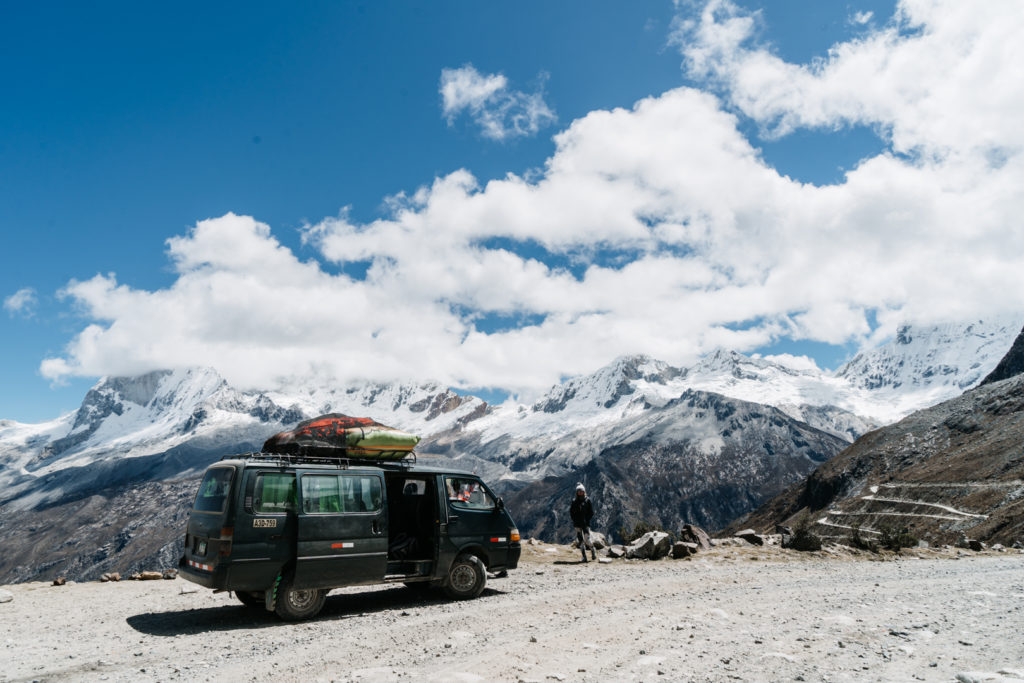
How to get to Huaraz from Trujillo
To get to Huaraz from Trujillo, you can also take an 8 – 9 hour overnight bus which can be booked with Movil or Linea. For easy booking and comparing prices, you can search and book your ticket on Busbud.
When choosing your ticket, note there are different seating options based on seat reclining degrees and other options. For example, cheaper seats only recline 140 degrees whereas premier seats recline 180 degrees, similar to a bed for better sleep – a game changer on those overnight trips.
Ticket prices are typically around S/65 ($17 USD) depending on when you book and which seat you choose.
After arriving in Huaraz, you can walk or take a taxi to your accommodation.
If traveling the other way from Huaraz to Trujillo, the process is the same.
ACCLIMATING TO THE ALTITUDE
When you arrive in Huaraz, before you do any activities you first need to acclimate to the high altitude. Huaraz is at 3,052 m / 10,013 ft and all the outdoor activities mentioned below are even higher. This can be a shock to the body and it’s absolutely essential that you give yourself time to acclimate before taking on physical activities.
For those wondering what acclimating means… basically there’s less oxygen at higher levels and your body needs time to get used to functioning while using less oxygen. If you’ve never been at a higher altitude like this, you can expect feeling more fatigued much easier, having headaches, getting dehydrated quicker and if you get major altitude sickness you can have other symptoms like nausea and diarrhea.
How can you avoid and treat altitude sickness?
Give yourself time to acclimate for at least 2-3 days before doing anything strenuous and anticipate that you may need to take it slowly. Make sure to drink lots and lots of water daily and stay nourished. To avoid altitude sickness you can also take medication (I personally recommend doing this before hiking) and drink coca tea – a popular beverage to help with altitude in Peru.
In the unfortunate scenario that you do get altitude sickness, it’s ideal to have altitude medication, Imodium, nausea meds, ibuprofen and electrolytes. If you’re able to descend from the higher altitude, do that otherwise take it very slowly and rest when you can.
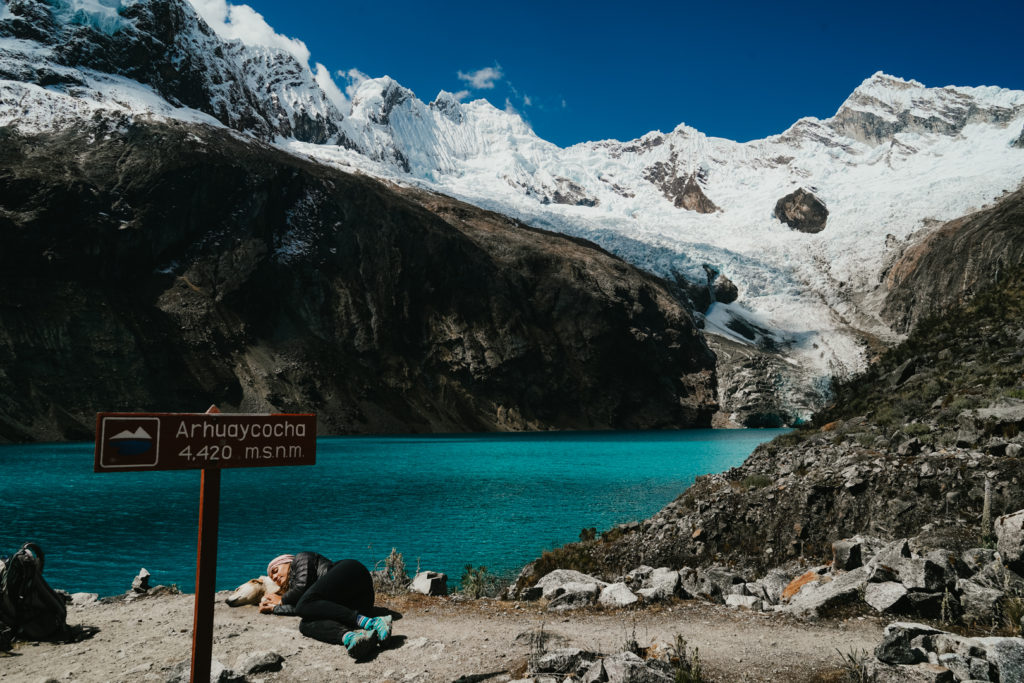
How to deal with high altitude while hiking?
While hiking, it’s essential to stay hydrated and take it slowly. You’ll notice physical activity is more difficult at high altitude and you may be out of breath very easily. That’s ok, just remember that how you react to the altitude doesn’t have anything to do with your fitness level. So without judgment, take it slowly and listen to your body.
For me personally, I feel like I never fully got used to the high altitude and even as someone in decent shape, every hike was exhausting and made me feel like I had asthma. But I learned to be patient and go at my own pace.
To avoid altitude sickness symptoms especially at the higher hiking trails, I also suggest taking altitude medication in the morning before even beginning your hike. You will still feel the effects in terms of exhaustion and difference in breathing, but you should minimize your risk for unwelcome symptoms (especially in the outdoors) like headaches, nausea and diarrhea. Personally I’m not a big medication person, but after getting these uncomfortable symptoms once during a hike which caused me to turn back, I’d rather just take the pill and avoid it altogether.
It’s also common in Peru to chew on coca leaves while hiking – something I didn’t find helpful but many do.
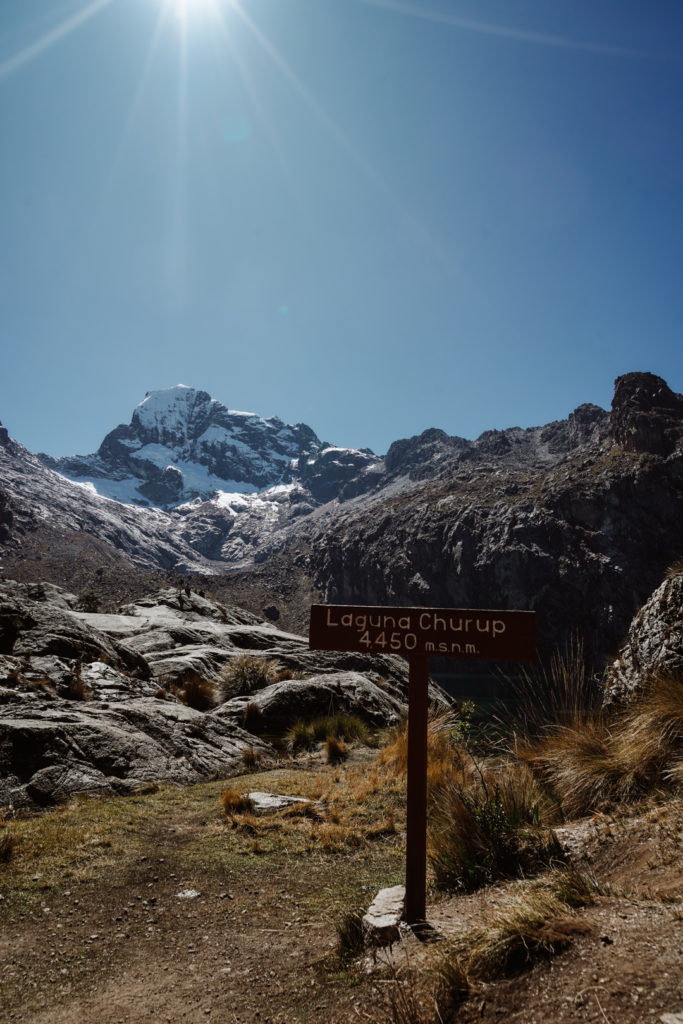
THINGS TO DO IN HUARAZ
1. Explore the city
When you first arrive, (like I mention above) it’s best to not have any physical activity immediately planned to allow yourself time to adjust to the altitude. Instead, spend your first day or two exploring the local market, walking through Plaza de Armas, shopping for gear, comparing tour options, hanging out at cafes, stocking up on snacks for hikes, and buying alpaca woven clothes for the cold nights.
Some exploring on your own is always encouraged, but here’s some places I enjoyed while in Huaraz:
- Mercado Central de Huaraz
- Plaza de Armas
- Artesian market of handmade knit clothing next to the Cathedral
- California Cafe
- Andino Cafe
- Cantuu Cafe
2. Do a day hike on your own
Many activities in Huaraz require or are more convenient to do with a guided tour because of transport. However, there are a few day hikes that you can do on your own by catching a colectivo or taxi to the trailhead and following the trail freely. These are all great as highlights to your Huaraz trip or as a means to acclimate before longer treks.
Laguna Churup
Laguna Churup is my most highly-rated day hike to do self-guided because it’s easy to complete on your own. It’s very straightforward to get to the trailhead and the trail is clearly marked. While still popular, Lake Churup is also not too touristy and it’s absolutely beautiful!
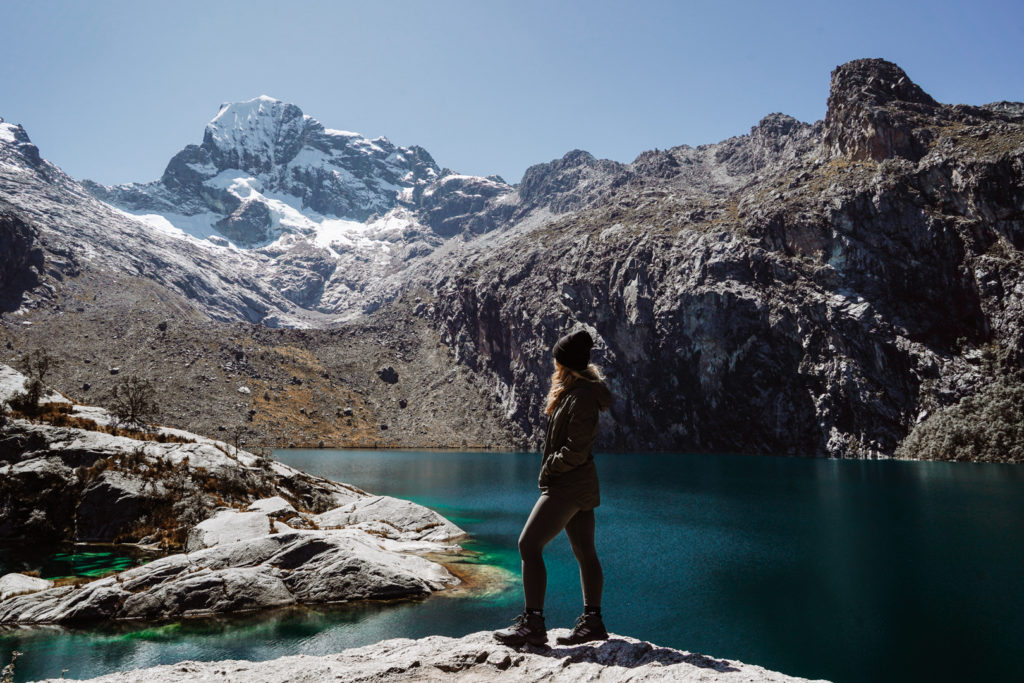
Length: 6 km / 3.6 miles in total
Height: 4,450 meters / 14,600 feet
Type of trail: In and out. The trail is a steady climb up, not technical although there is a small portion where you’ll need to grab onto chains to climb up, but it’s nothing too difficult.
Time: From the bus stop, it’s about a 45 minute drive to the trailhead. The hike up takes about 2-3 hours to complete on average. At the top, you’ll probably spend about an hour there (or longer if you want to swim), and finally the way down is about 1.5 hours followed by a 45 minute drive back to Huaraz. Altogether, you should expect to leave Huaraz at 7am and be back around 3/4 PM (if you catch the earlier buses back) making your trip in total about 7-8 hours.
Location: Laguna Churup is about 45 minute drive from Huaraz, in Huascaran National Park, specifically in an area called Pitek.
Getting there: To get to the Laguna Churup trailhead, it’s pretty simple. In Huaraz, go to the intersection of Avenue Agustin Gamarra and Avenue Antonio Raymondi. It’s here on Google Maps but also labeled as “Bus to Llupa” or “Combi hacia Llupa” on Maps.Me. From here you can catch a colectivo van by paying 20 soles round-trip and they will drop you off directly at the trailhead. Colectivos begin leaving at 7am and leave thereafter pretty frequently whenever the bus is full.
My suggestion is to arrive at 6:45 AM and catch the first bus at 7 AM. To get back to Huaraz, the vans begin around 2 PM and leave every half hour or so once they are full. In my experience, this was a very organized system where the driver gave me a ticket, explained pick up times, and it honestly felt more reliable than many of the tours I went on.
Entrance fee: The Huascaran National Park fee is S/30 ($8 USD). If you plan to do more activities soon after, there’s also a 3 day pass for S/60 ($15 USD) and a month pass for S/150 ($38 USD).
Solo travel approved? Absolutely, yes! It’s easy to meet others while in Huaraz to join you on this hike, but even if you don’t and end up venturing out alone, the trail is plenty safe and there will be many other backpackers on the collectivo who will join you on the trail. Just make sure to have all the right gear you need in case.
Laguna 513
Laguna 513 is comparable to Laguna 69 (read more later in this post) minus the crowds and features bright blue water with a towering Hualcan mountain peak behind. It’s a well-marked trail that’s easy to do on your own and perfect to acclimate before doing longer treks.
Length: 15 km / 9 miles
Time: 6-7 hours to complete not including transportation
Type of trail: In and out
Height: 4,431 meters / 14,537 feet
Elevation gain: 865 meters ~ 2,837 feet
Location: The trailhead begins in Carhuaz from an area called Shonquipampa, about an hour drive from Huaraz.
Getting there: It’s possible to reach the trailhead by a private taxi all the way there, or by taking a colectivo to Carhuaz and then a taxi into the Shonquipampa valley. There are also some tours available for Laguna 513 that you can find in the city.
Entrance fee: None!
Solo travel approved? This is a well-marked trail so if you’re confident in hiking alone it’s possible to do, just make sure you have all the appropriate gear and are prepared. Otherwise, I suggest finding some friends to join you, or there are a few tours available in Huaraz.
Laguna Llaca
Laguna Llaca is a much less popular trail and good for those who are really trying to get off the beaten path. I didn’t do it myself, and there’s little information on the internet about it, but I did meet a Peruvian guy and Dutch girl who completed the hike, both of which said it was stunning and a unique experience compared to the other busy Huaraz lakes. However, it seems there is a bit more work to get there, so this is for the adventurous, and down-for-whatever travelers.
To learn more about this trek here it is on AllTrails and a helpful review on TripAdvisor. But remember, not everything is on the internet, when in doubt ask someone at your accomodation reception, other travelers, or tour guides about Laguna Llaca.
Length: AllTrails lists this as an 18 km / 11 miles hike
Time: This is a longer one, and will take about 7 hours to complete not including transportation
Type of trail: In and out
Height: 4,470 meters / 14,665 feet
Elevation gain: 938 meters / 3,077 feet
Location: This is close to where Laguna Churup is located, about 27 km out of Huaraz in Huascaran National Park.
Getting there: It’s possible to take a private taxi (ask – they’ll know where to go and give you a price) or take a collectivo to Marian and then start the trail from Lazy Dog Inn.
Entrance fee: The Huascaran National Park fee is S/30 ( $8 USD). If you plan to do more activities soon after, there’s also a 3 day pass for S/60 ($15 USD) and a month pass for S/150 ($38 USD).
Solo travel approved? Ishhh… because of the difficulty to navigate getting to this lake I would personally not do it alone. However, if you meet a group of people who want to join and split a taxi, then I would absolutely go for it! Just make sure to have all the appropriate gear you need just in case.
Other honorable mentions for day hikes that I’ve heard of but admittedly know nothing about are Laguna Radian, Laguna Rajucolta, and Laguna Wilcacocha for those who want more day hike options in Huaraz.
3. Take a tour to Laguna Paron
Laguna Paron is one of the most popular day trips you can do in Huaraz because it has absolutely stunning views for almost no physical effort. For those looking for a wild hike, this may sound disappointing but it’s a great way to acclimate and a staple activity in Huaraz. If you’re lucky enough to have clear skies, you’ll see the shiny mountain peak the Paramount Pictures logo is inspired by and yes – the water really is that blue.
What’s included in a tour to Laguna Paron and what to expect:
All tours to Laguna Paron are the same. You’ll be picked up from your hotel or hostel around 8 AM and then have a 3 hour drive in a van stopping once in Carhuaz, where you’ll have 25 minutes to grab snacks and try the famed ice cream in town. From there, the van will drop you off directly at the base of Lake Paron.
The view is spectacular just from the bottom, but you’ll have 2 hours to further explore the area. Some options are hiking 30 minutes up to the mirador, walking around the lake, and even taking a kayak or rowboat on the water for an extra S/10-20 ($3 – 5 USD). I suggest starting with the mirador to ensure you get that panoramic view and saving any extra time for further activities.
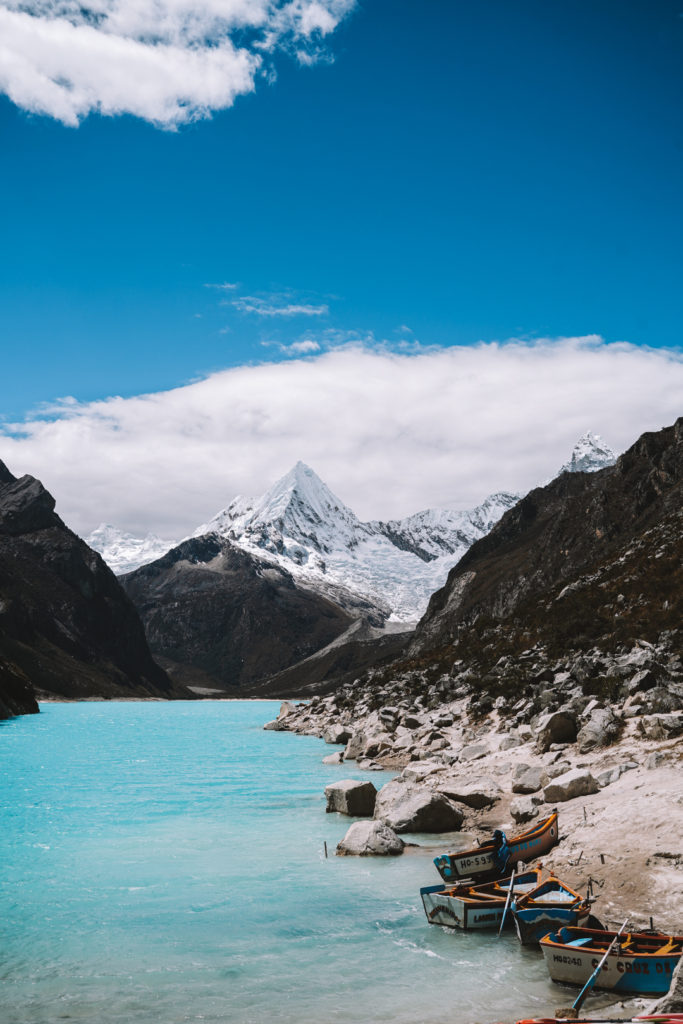
How difficult is a tour to Laguna Paron?
In terms of physical difficulty, not difficult at all. You’ll be dropped off at the base of the lake, so the only hiking you need to do is walking 30 minutes up to the optional mirador.
How long is a tour to Laguna Paron?
In total, the whole trip should be about 9-10 hours, pick-up at 8 AM and arriving back in Huaraz around 5 or 6 PM. While the highlight of the trip is obviously the incredible lake views, the majority of your time will be spent in a car so be prepared by having podcasts, movies, music, and/or a book downloaded for the ride.
Where to book a tour to Laguna Paron:
I recommend booking through Krusty Travel Hostel which usually has the best prices and is a good place to stay as well. If they’re not offering it at the time, American Tours and Golden Expeditions have competitive prices, as well.
Price: A tour to Lake Paron is S/50 ( $12 USD) per person + an entrance fee to the park for S/5 ( $1.5 USD).
4. Witness Pastoruri Glacier
Once the highlight of visiting Huaraz back in the day, Pastoruri Glacier is sadly melting due to global warming. But before it goes, it may be worth a visit if you’ve never seen a glacier up close and want another day trip with little physical challenge to acclimate.
The glacier itself sits at 5,000 meters and is one of the few glaciers left in the tropical region of South America. In my honest opinion, it was much smaller than seen in past photos but still interesting to see up-close (however it will become less impressive as time goes on, unfortunately). The tour also helped prepare my body for high elevation, and the drive was stunning. In fact, the road to Pastoruri Glacier is one of the highest paved roads in the world.
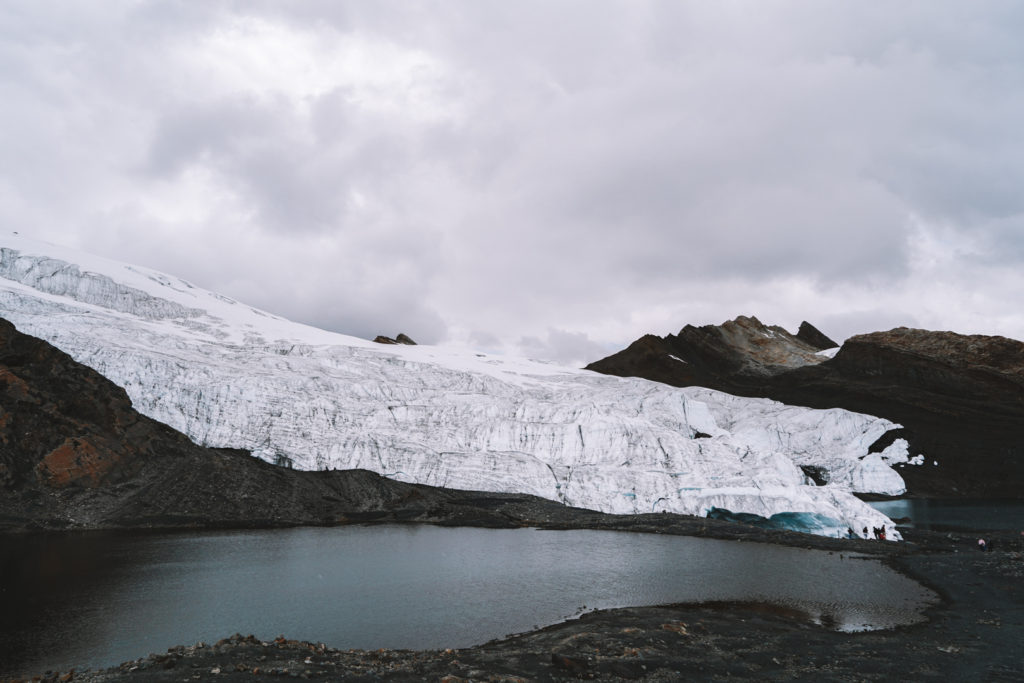
What’s included in a tour to Pastoruri Glacier and what to expect:
A day trip to Pastoruri Glacier includes pick-up from your hotel at 9 AM and a 3 hour drive to the glacier trail. Along the way, you’ll stop at a restaurant for a quick cup of tea and to make a reservation for lunch later, followed by two separate viewpoints along the road for a picture, then finally make it to the glacier.
From the parking lot, you’ll walk along a paved trail about 30 minutes up to the glacier. While the trail is not technically difficult at all, the altitude leaves you pretty winded so just take your time.
You’ll have about 2 hours to explore the glacier (including the walk there and back) and then head back to Huaraz, stopping one last time at that same restaurant for a late lunch before arriving back in Huaraz at 5 or 6 PM.
How long is a tour to Pastoruri Glacier?
In total, the trip is about 8 hours, from 9 AM – 5 PM.
How difficult is a tour to Pastoruri Glacier?
Not too difficult. It’s about a 30 minute walk to the glacier, which is somewhat uphill but nothing crazy. You will be out of breath because of the sheer height of the area, but with patience almost anyone could do it.
Where to book a tour to Pastoruri Glacier:
I recommend booking through Krusty Travel Hostel which usually has the best prices and is a good place to stay as well. If they’re not offering it at the time, American Tours and Golden Expeditions have competitive prices, as well.
Price: A day trip to Pastoruri Glacier costs about S/35 – 45 ($9 – 12 USD) + an entrance fee to the park which is about S/30 ($8 USD).
5. Hike to Laguna 69
This is the day trip that draws most tourists to Huaraz these days, the famous Laguna 69. Sitting at 4,600 meters is a crystal blue lake reflecting the icy peak of Chakrarahu. Visitors will walk through a vast valley passing cows feeding on grass, and trudge up two ascents past a waterfall, Laguna Lago and then finally making it to Laguna 69.
Thanks to social media, this lake has gone absolutely viral and 100’s of tourists visit everyday. But despite being tainted in over-popularity I still highly, highly recommend visiting Laguna 69. Not only is it a staple to Huaraz, but a practical way to acclimate for longer treks because of the elevation and the double ascents to get your stamina working.
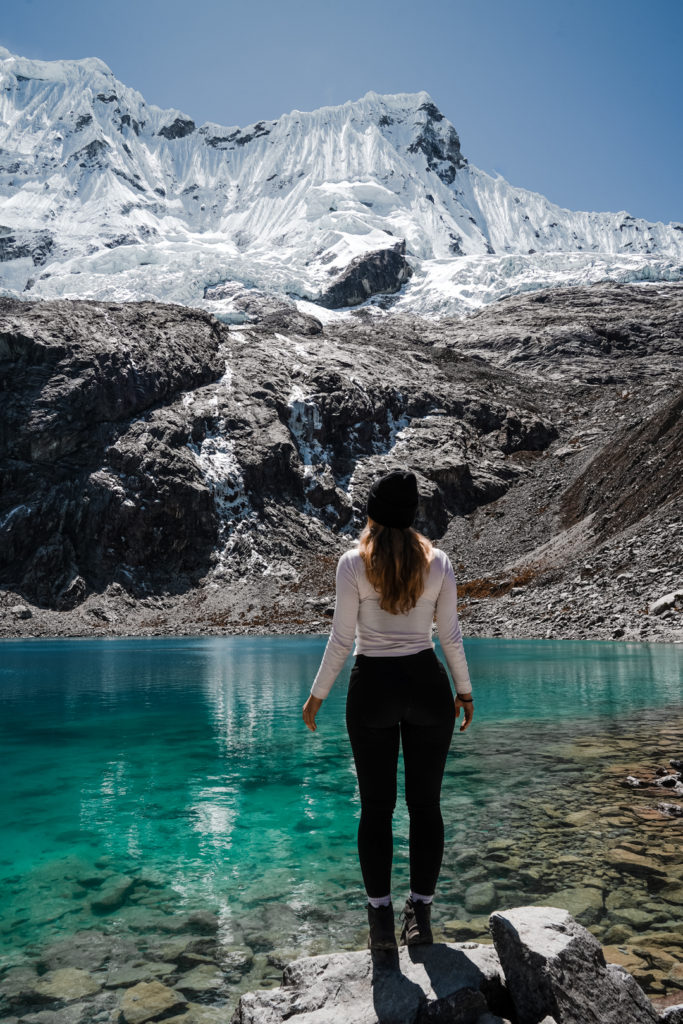
What’s included in a tour to Laguna 69 and what to expect:
A tour to Laguna 69 includes pick-up at your hotel or hostel at 4:30 or 5 AM, transport to and from the lake, and a licensed guide.
The drive to and from the lake is a long one, about 3 hours one way without stops. However, in the morning along the way you’ll actually make two stops: one for breakfast (which you’ll pay for separately), and one nearly at the trailhead at Laguna Llanganuco to take a quick picture.
You’ll start hiking at about 9/10 AM and have about 6 hours to complete the trail. To stay on track, the guides will recommend that if you are not at the lake by 1 PM you’ll need to turn back regardless to head for the bus so that the group leaves by 3 PM for Huaraz.
Trail Length, Difficulty & Details of Laguna 69
Laguna 69 is a 14 km (or 8.6 miles) in and out trail that begins with a walk through a valley, a first ascent of switch-backs, another flat walk, and then another final switch-back ascent to the lake.
While people of varying physical abilities complete this day hike, it’s definitely not a walk in the park. Because of the altitude & length it can be tough so it’s best to come prepared and have at least a day or two to acclimate in Huaraz. During the trail, it’s important to take it slow, listen to your body, and drink lots of water. If you’re worried about altitude, it’s worth taking medication beforehand as well – in fact, I recommend it.
Where to book a tour to Laguna 69:
I recommend booking through Krusty Travel Hostel which usually has the best prices and is a good place to stay as well.
Price:
A tour to Laguna 69 is about S/50 ($12 USD) + the entrance fee to Huascaran National Park for S/30 ($8 USD). If you plan to do more activities in the park soon after, there’s also a 3 day pass for S/60 ( $15 USD) and a month pass for S/150 (~$38 USD).
6. Kayak at Laguna Llanganuco
If you’re not feeling up to the challenge of Laguna 69, you can still make it up that way to Laguna Llanganuco where you can kayak and enjoy the vast, turquoise lake. In all honesty, if you’re doing Laguna 69 I don’t think it’s worth it to come all this way again for Llanganuco, however this is a great option for those with limited physical ability who still want to enjoy the outdoors or for those traveling with kids.
Where to book a tour to Laguna Llanganuco?
I recommend booking through Krusty Travel Hostel which usually has the best prices and is a good place to stay as well. If they’re not offering it at the time, a number of tour groups in town are safe to go with, all of them offering a similar tour so just go with the best price.
7. Ice Climbing Mateo Summit
On the other end of the spectrum, a challenging and rewarding day trip is ice climbing to summit Nevado Mateo. If you’ve ever wanted to summit a mountain, this is a great opportunity because as far as summits go, it’s minimal effort since it begins high up and therefore can be done in only a day. But even still, it’s a brag-worthy activity to reach the top of this 5,150 meters (16,896 feet) mountain peak plus you’ll have the opportunity to try ice climbing with ice axes, a harness, and all.
What’s included in a tour to Mateo and what to expect:
A tour to Nevado Mateo Summit should include all the equipment needed for an ice climb, so no need to rent gear. Get some sleep the night before, because this is an early tour with pick-up from your hotel or hostel at 3:00 AM. The drive to the trailhead is about 2 hours, so you’ll start climbing around 5/5:30 AM.
The climb itself is 3 km/1.8 miles with a 400 meter/1,300 feet elevation gain and will take about 2 hours to go up. Because of the altitude, expect to be walking very slow which is completely normal. In total, the trip should be about 9 hours so you’ll return to Huaraz mid-day.
Where to book Mateo ice climbing:
I suggest booking through Krusty Travel Hostel which typically has the best prices, provides high quality gear and is a good place to stay making it a convenient option especially when being picked up at 3 AM. The day before the climb they’ll also have you try on boots and make sure you’re ready to go.
Price:
Ice-climbing Nevado Mateo Summit is about S/200 ($50 USD) + the entrance fee to Huascaran National Park for S/30 ($8 USD). If you plan to do more activities in the national park soon after, there’s also a 3 day pass for S/60 ($15 USD) and a month pass for S/150 ($38 USD).
8. The Santa Cruz Trek
Out of everything to do in Huaraz, without reservations I cannot recommend the Santa Cruz trek enough. During this 4 day trek you’ll walk through vast valleys, through blooming meadows, up to a polar lake, climb to Punta Union pass, and camp under the stars.
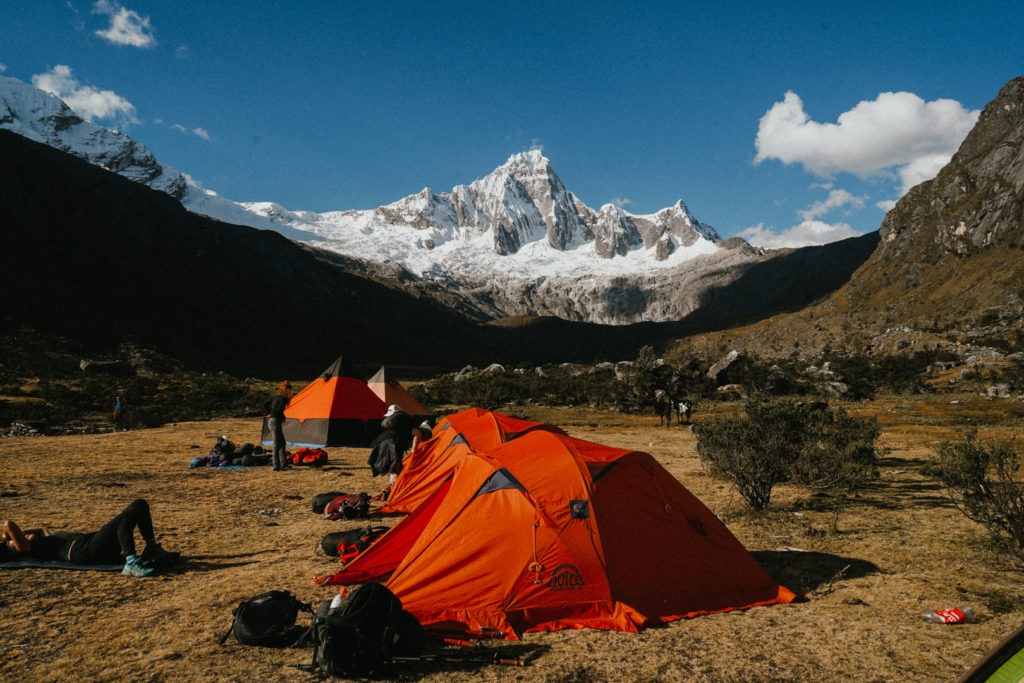
Beyond the impressive scenery, Santa Cruz is perfect for many tourists for a variety of reasons: it’s super affordable, it’s not too long, and it’s ideal for first-time trekkers! While it comes with some physical challenges, I think it’s totally doable for the average able person.
I ended up doing this hike in preparation for the Huayhuash trek, and while it wasn’t my main focus coming to Huaraz it ended up being a major highlight. Santa Cruz was just challenging enough to be rewarding, but not so demanding that I couldn’t enjoy the moments in nature, feeling the mountain breeze and photographing memories. A major bonus was enjoying it all with two other solo female travelers I met, joking our way through cold nights in the tent and long days walking.
Besides the famed Huayhuash trek (read below), which may not be for everyone, Santa Cruz is one of the best things you can do in Huaraz, so be sure to make room in your Peru itinerary!
Distance, Difficulty & Details of the Santa Cruz Trek:
The Santa Cruz trek is 4 days and 3 nights hiking trail through the Cordillera Blanca that covers about 50 km (32 miles) and reaches the highest elevation of 4,750 meters (15,583 feet) at Punto Union Pass.
The map of the trek is shown below on AllTrails (which is roughly accurate) but when you discuss with tour operators they should give you a map and explain the hiking details of each day.
What to Expect from the Santa Cruz Trek: what’s included, camping conditions, weather, etc:
Most tour operators include the same: a licensed guide with a first-aid kit, camping equipment including tents, sleeping mats, and sleeping bags, all of your meals provided (except for the first breakfast at a homestay), transportation, and mules to carry a bag with your belongings.
What’s not included is any clothing, hiking poles, hiking boots, travel insurance and a water bottle – although water is provided. Additionally, most tours don’t include the Huascaran National Park entrance fee which is S/30 ($8 USD).
In terms of weather…you can definitely expect pretty cold nights dropping to or below freezing. During the day, the weather can vary between sun and heat, or clouds and maybe rain. This will vary depending on season, elevation, and just luck.
As for camping, the conditions are pretty simple for Santa Cruz: just you, a sleeping bag and a tent. No fires are allowed and the Santa Cruz campsites do not offer any amenities like toilets or a shower.
If you’re not used to camping like this, it will probably be the most rough part of the trip. But it’s only 4 days and *hopefully* you get used to it. My biggest recommendations are to bring plenty of layers to stay warm, something to serve as a comfortable pillow, maybe another item to cushion your hips from the ground, toilet paper and a plastic bag to toss trash, and wet wipes to clean yourself.
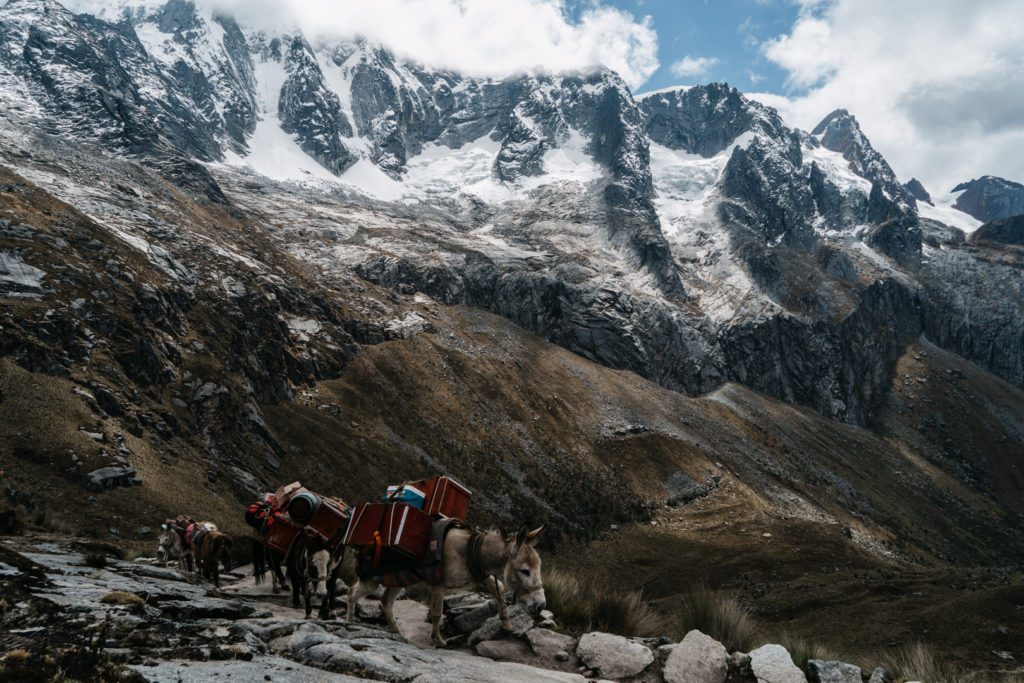
Where to Book the Santa Cruz Trek:
The Santa Cruz trek is available from a number of tour operators in Huaraz but I found the cheapest option was through Krusty Hostel who uses Huayhuash Expeditions. They were professional, provided a duffle bag for my things, easy to book with and were the most affordable compared to other tour groups. They’re also a comfortable B&B so it’s convenient to book a night’s stay there before and after your trek while they hold onto your remaining luggage.
Price of Santa Cruz Trek:
Booking through Krusty Hostel, the Santa Cruz trek was S/600, roughly $150 USD and the best price you can find in Huaraz. Another guy in my tour booked elsewhere and paid 200 soles more with nothing extra provided (if anything, less because he wasn’t provided a duffle bag).
9. The Huayhuash Trek
Named one of the 10 most beautiful treks in the world, the Cordillera Huayhuash circuit should absolutely be on your bucket list. While it’s not for the faint of heart, the magnificent views of snow-capped peaks, turquoise glacial lakes, rocky terrain, and mind-blowing views pay off all the challenges of the trail. Over 5-12 days you’ll push your strength and stretch your stamina for one of the most rewarding and immersive adventures through the Andes Mountains.
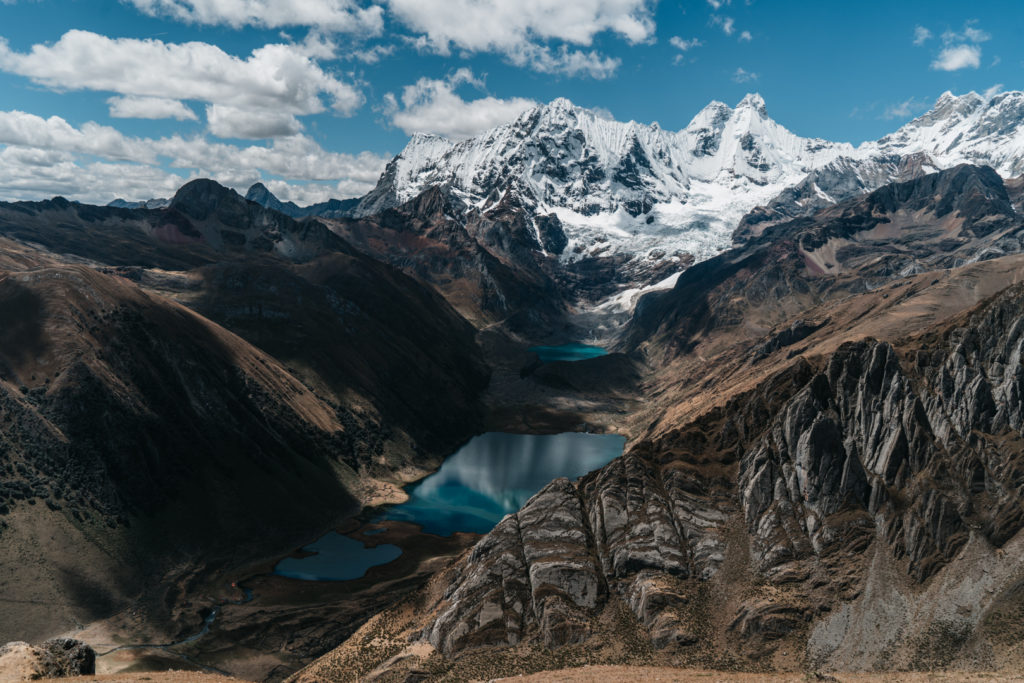
Full disclosure, the Huayhuash circuit is a difficult one, and for many reasons: not only trail distance, but for the high altitudes and mental stamina to span over the whole trip. About every day is a mountain pass, and the entire trip is over 4,000 meters, the highest reaching 5050 m / 16 568 ft. Weather can be unpredictable up there, and you may need to hike or sleep through hail or even snow. What’s more, how your body reacts to these conditions – especially the altitude – can also be challenging.
On the other hand, as long as you have the proper gear, the mental fortitude, are properly acclimated, and in good enough physical condition, the hike itself really isn’t that technical. Just one foot in front of the other!
So if you’re up to the challenge, I can surely tell you Huayhuash will be an adventure of your lifetime.
Distance, Difficulty & Details of the Huayhuash Trek:
The traditional Huayhuash circuit is considered difficult and can be done in 8-12 days. The most popular route is 8 days, which is what I did and what I’ll speak about.
During the 8 days Huayhuash Circuit you’ll hike about 130 km/80 miles and reach elevations as high as 5,050 m / 16 568 ft. Unlike the Santa Cruz trek which centers around one mountain pass, during Huayhuash you’ll do about one mountain pass every day which makes it a much more demanding trek.
The map of the circuit is shown below on AllTrails (which is roughly accurate) but when you discuss with tour operators they should give you a map and explain the hiking details of each day since there can be slight variations.
What to Expect from the Huayhuash Trek: what’s included, camping conditions, weather, etc:
Most tour operators include the same for the Huayhuash trek: a licensed guide with a first-aid kit, camping equipment including tents, sleeping mats, and sleeping bags, all of your meals provided (except for the first lunch at the restaurant in Llamac), all transportation, and mules to carry a bag with your belongings. Some tours (like with Krusty Hostel/Huayhuash Expedition) will also include the park entrance fee and an emergency horse to ride in case.
What’s not included is any clothing, hiking poles, hiking boots, personal items, travel insurance and a water bottle – although water is provided.
In terms of weather, expect it all. At night and in the morning you can guarantee it’s going to be frigid, with temperatures at or below freezing. During the day you can guarantee you’ll have everything from hot, to cloudy, to cold, to hail, and maybe even a snow storm (if you’re lucky like me…). My group joked that every day in our day packs we needed clothes for all seasons, and the story of our lives was stripping and adding layers every other hour.
As you can imagine, this is no luxury stay. You’ll be camping in tents throughout the trip except for one day where a hostel is optional. Fortunately, unlike the Santa Cruz trek there were toilets at every campsite. Not always the best, but they did provide some privacy. Halfway through the trek, we also camped in a village where a shower was available and if you wanted to pay extra, this is where you could stay in a hostel.
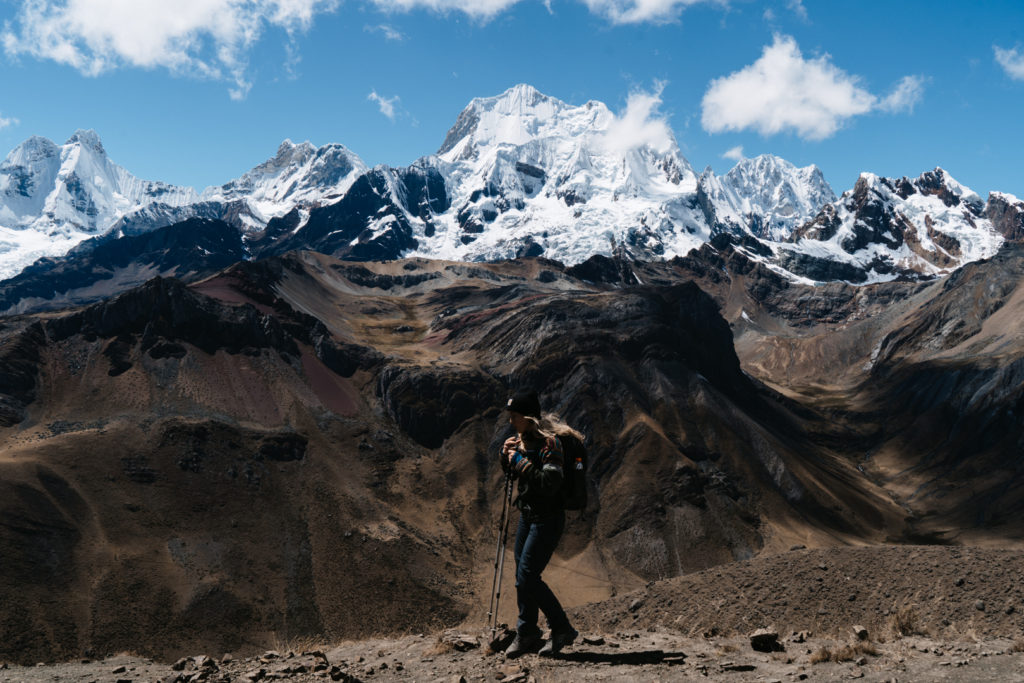
Where to Book the Huayhuash Trek:
I’ve recommended Krusty Hostel to book all tours throughout this blog post, but for Huayhuash I really, really recommend it. I shopped around a lot for the Huayhuash trek in Huaraz and Krusty Hostel offered the lowest possible price at S/1500 ($390 USD). I was extremely pleased with the gear, my guide, the group, and the entire experience. They provided a spacious duffle bag so you don’t have to pick and choose with fresh layers, the guide was encouraging and hilarious, an emergency horse and the entrance fee were included, and it’s a popular place to book the trek so I was paired with the best group of fellow backpackers I could have possible asked for, especially going into it not knowing a soul.
Price of the Huayhuash Trek:
When booked through Krusty Hostel, it’s S/1500 ($390 USD) for 8 days. Everywhere else in Huaraz who I spoke to was charging anywhere from S/1700 – 2500 a lot of times depending on group size.
10. Take a self-care day and get a massage
After all that hiking, you deserve a self-care day – my final recommendation of things to do in Huaraz. In between my Santa Cruz and Huayhuash trek I treated myself to a full-body 1 hour massage at Centro de Masajes Huaraz. It was S/80 ($20 USD) and worth every penny after long days of pushing my body to its limit.
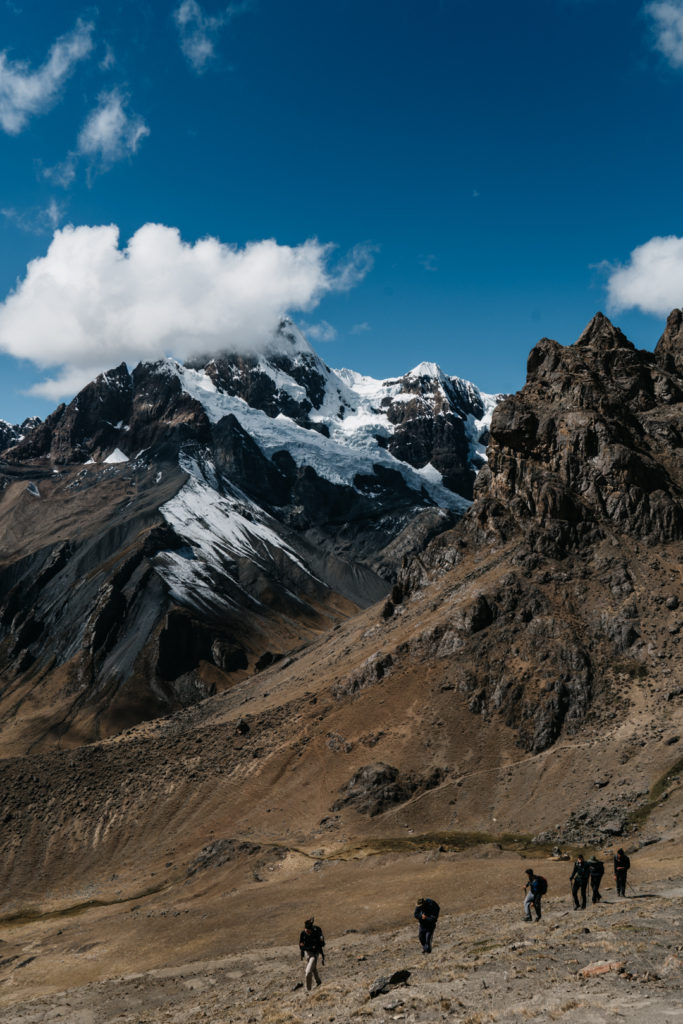
WHERE TO BOOK TOURS IN HUARAZ
As mentioned already, I most recommend booking all tours through Krusty Hostel who works with Huayhuash Expeditions for longer treks. In my experience they always had the best prices and provided high quality gear.
Once I discovered Krusty, they were my go to. Throughout Huaraz you’ll see ‘TOURS’ signs everywhere and are welcome to shop around. However, after booking a few different tours myself with different groups I found that they all offer the exact same packages (sometime even combining groups) and service was never anything to write home about; therefore the only thing that really mattered was price. Once I discovered Krusty had the best prices, it saved me time and energy.
How far in advance do you need to book tours?
For day tours you typically don’t need to book anything more than 1-2 days in advance unless it’s a holiday. However for activities leaving early morning between 3- 5 AM, try to add a time cushion the day before.
For a longer trek such as Santa Cruz or Huayhuash you might want to secure your spot much earlier, just in case. As soon as you arrive in Huaraz or after you’ve done your first hike I would book these. Even still though, I booked Santa Cruz one day before leaving and Huayhuash two days before.
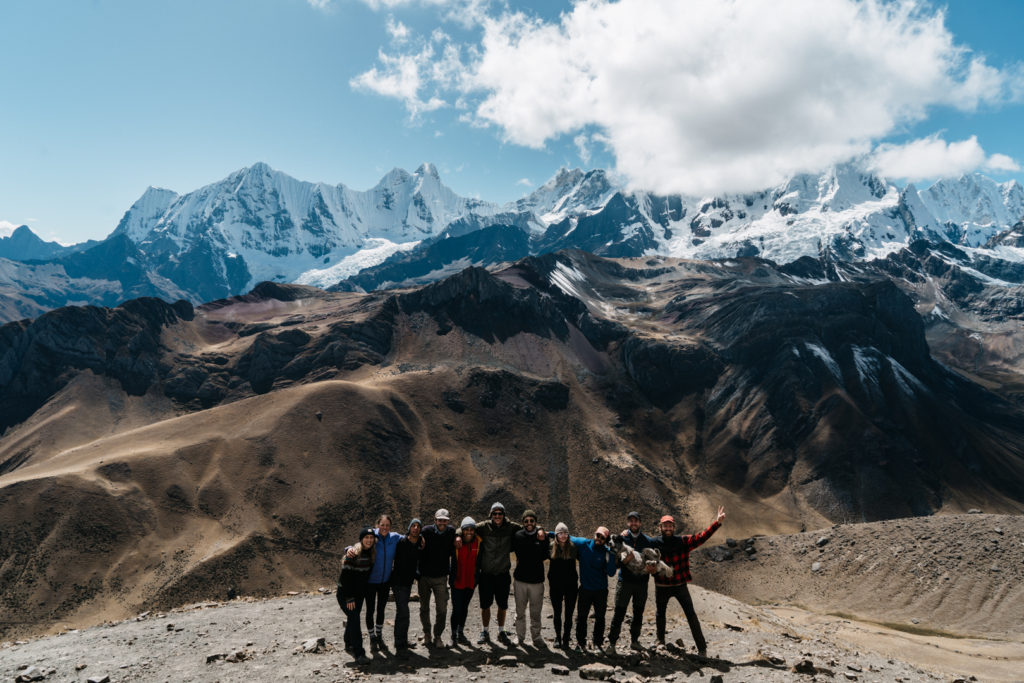
WHERE TO RENT AND BUY GEAR IN HUARAZ
If you’re looking for hiking clothes, you can find everything from windbreaker jackets, winter coats, hiking pants, base layers and more at a number of outdoor apparel stores in Huaraz on the main street. Many sell high-quality brands such as Patagonia, Cotopaxi, Columbia, etc. However don’t expect lower prices, you’ll find about the same name-brand prices you’d find in the U.S.
For those on a budget or backpackers who only need a quick, cheap solution for a one-time trek, there are also plenty of places where you can buy clothing second-hand for a fraction of the cost. On the same street as the Central Market just behind the main street, you’ll find such stores to shop around. I bought a NorthFace windbreaker jacket for about $25 USD and two breathable sweat proof t-shirts for $7 each.
If you’re looking to rent gear or equipment such as hiking poles, tents, sleeping bags, or even winter coats then I recommend Mont Blanc Trekking & Climbing.
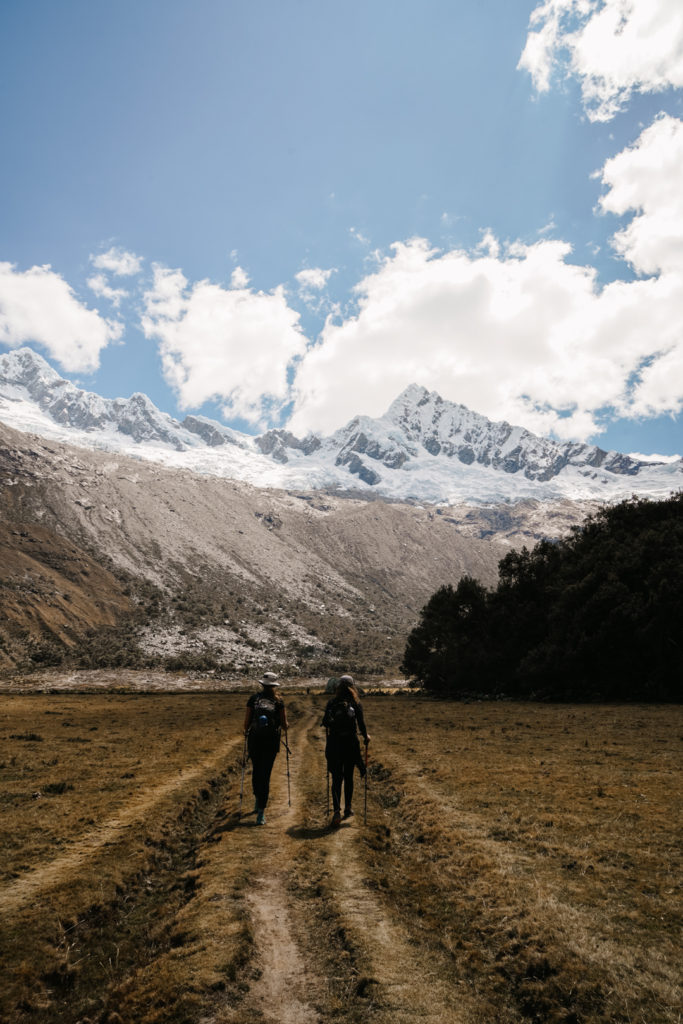
WHERE TO STAY IN HUARAZ
Budget $
For the backpackers and budget travelers, I recommend staying at Krusty Hostel. It’s nothing fancy, but I found this B&B a really comfortable stay and a bang for your buck. The dorm rooms are about $8 USD a night, and have larger twin beds that are not bunks which is a major plus. Private rooms are also available for about $20 USD. The showers are always hot, breakfast is included, there’s a rooftop, fast wifi, and it’s where I recommend booking tours from as well.
Mid-Range $$-$$$
If you’re looking for a step up in accommodation from the broke backpacker budget, try Selina. They have both comfy dorm rooms and privates available at their beautiful courtyard stay which also features a spacious kitchen for cooking, several rooftop balconies, a cowork space, yoga studio, and movie theater. Note, they do host events late into the night on weekends, so if you have an early wake-up call be aware there will be loud music Friday’s & Saturday’s. However, if you’re the party hard and still wake-up and hike type, this is for you. Otherwise, during the week it’s pretty chill.
Overall, most stays in Huaraz will be very much homestay/lodge style; you won’t find massive chain hotels in this mountain city. However, since most of your time in Huaraz will be spent in the mountains anyways, you don’t really need anything too fancy. The most important things to have wherever you choose is a hot shower, warm blankets, and in relative proximity to the main square to book tours, etc.
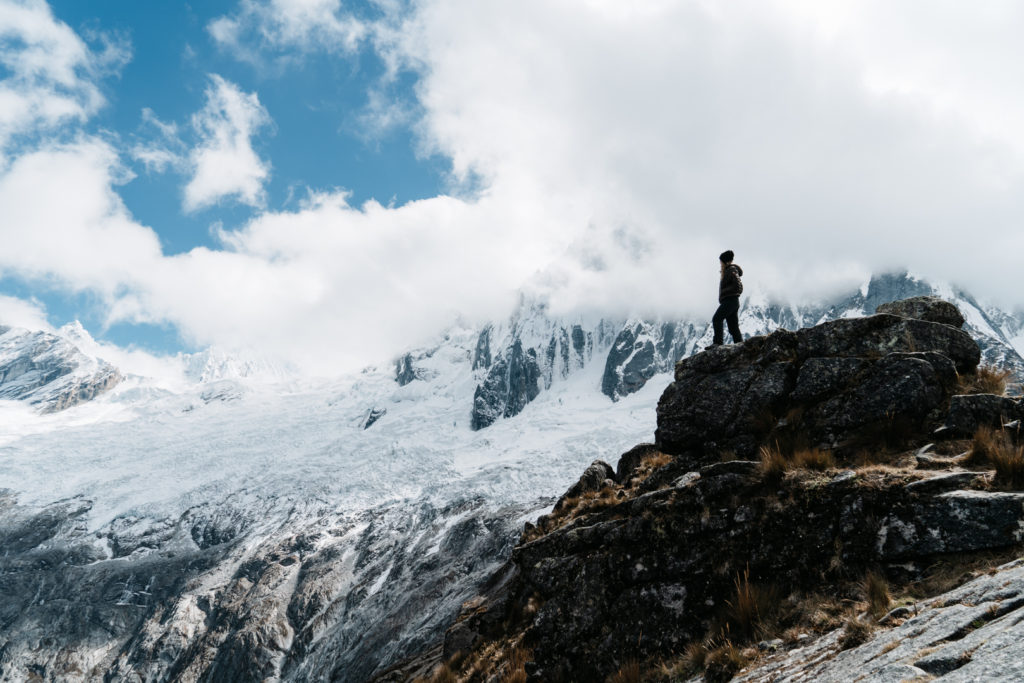
WHERE TO EAT & DRINK IN HUARAZ
Andino Cafe
Andino has fantastic food at all hours of the day but I especially loved the Andino breakfast which included homemade bread, fresh juice, a nicely brewed Americano, perfectly scrambled eggs, breakfast potatoes, pico de gallo, and a spicy mango salsa. It also has great wifi if you want to stay and chill – although there are no outlets which may shorten your stay.
California Cafe
This is a great hangout spot if you’re having a slow day while acclimating, just have some downtime or are looking for a cafe with good wifi to work from. The only thing, I’ll admit, is the food was not anything special to me. Not bad at all, but not special (I came for the atmosphere) – although the pancakes are impeccable. You can also find a lot of guide books and information about trekking here.
Paulino’s Indian Cuisine
If you love indian food and are craving something besides Peruvian food, I highly recommend Paulino’s. For a mountain town in Peru it was surprisingly pretty decent indian food and the hearty meal I always needed after trekking. In fact, I went about 3 times and thought about it through my whole Huayhuash trek!
Cantuu Cafe
Cantuu is a small vegan cafe that serves breakfast items, hamburgers, sandwiches, pizzas and other items. Although I’m not vegan, I loved this little spot as a place to grab a coffee, piece of cake or avocado toast and chill. They also have great wifi!
Pashta
If you’re looking for a quick and affordable lunch, Pashta has good sandwiches made with quality bread for around S/9 ($3 USD).
Archies
For the Americans or others craving some soul food, Archies is your place. There was one day I had a mean craving for fried chicken and stumbled upon Archies and it did the job with a huge crispy portion accompanied with ranch and a spicy sauce.
Trivio
This is a good all-rounder restaurant with various options to suit a large group. They also have great cocktails, I recommend the various pisco sours!
Wintata Karaoke
I didn’t party much in Huaraz, but out of the two nights that I did – this was my favorite spot! After trekking Huayhuash my entire group celebrated by getting drunk and having a night of karaoke. Highly recommend ending your trip on this note.
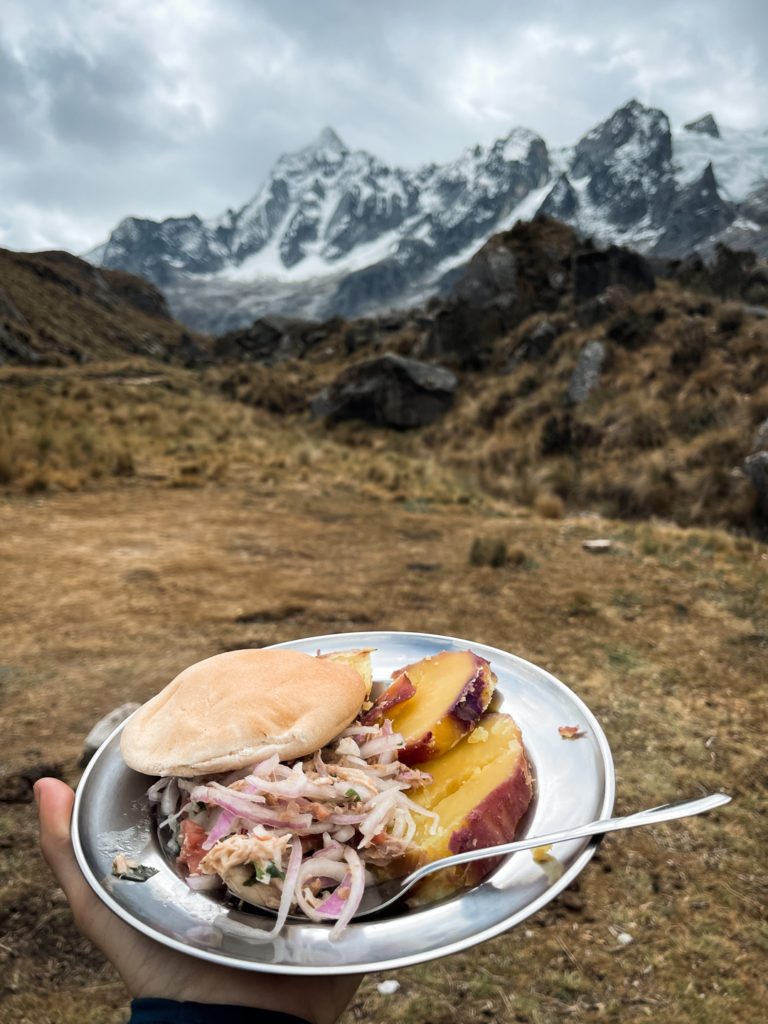
WHERE TO BUY GROCERIES IN HUARAZ
Whether you’re cooking a lot in Huaraz or looking for somewhere to buy food/snacks for trekking, you can find everything you need at the local grocery store known as Trujillo. They’re all over Huaraz.
Additionally, there’s a local market known as Mercado Central de Huaraz where you can also find fresh produce. Keep in mind if you plan to do multi-day trekking on your own, you won’t find any dehydrated food in Huaraz and will need to bring it yourself either from Lima or your home country.
HOW LONG SHOULD YOU STAY IN HUARAZ?
This totally depends on what activities you plan on doing and if you want to do multi-day treks like Santa Cruz or Huayhuash. To figure out how long you should stay, decide which activities you want to do, tack on 2-3 days to acclimate if coming from sea level, and then consider any rest days you want to have in between activities.
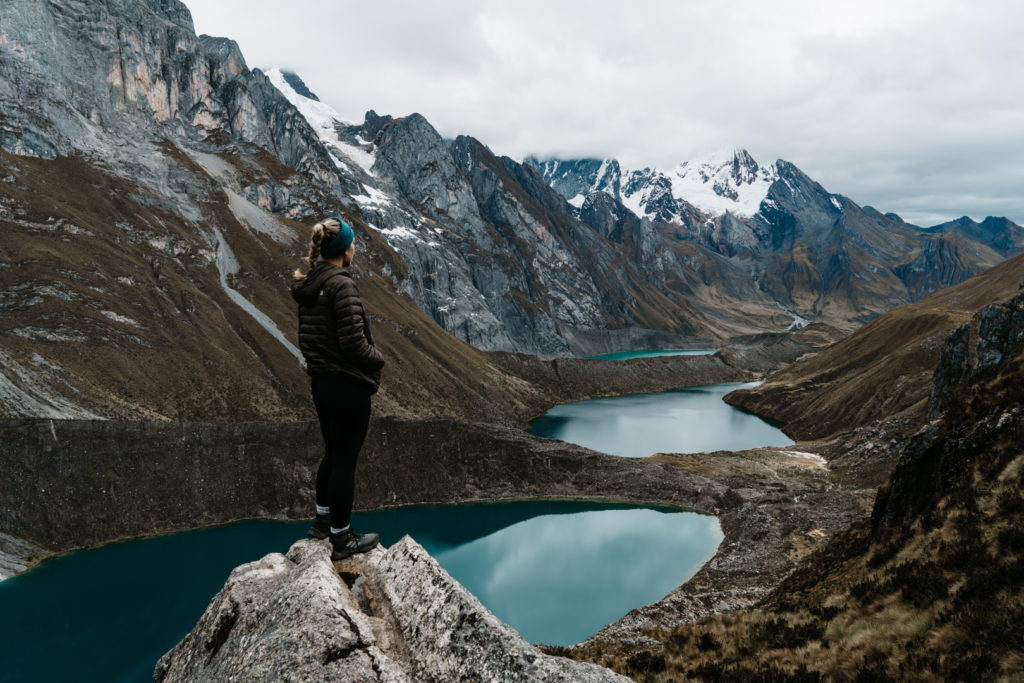
WHEN IS THE BEST TIME TO VISIT HUARAZ?
The best time to visit Huaraz is from May to September. This falls during Peru’s winter but it’s also dry season which means you’ll mostly avoid rain during hiking.
Normally traveling outside of a peak season can be beneficial because it means less people and lower prices, but in this case I would not recommend it. I mean why visit the mountains anytime outside of mountain season? It would be a shame to miss out on activities because conditions are bad or hike a long way just for the views to be covered in fog or rain. My advice: stick to May – September.
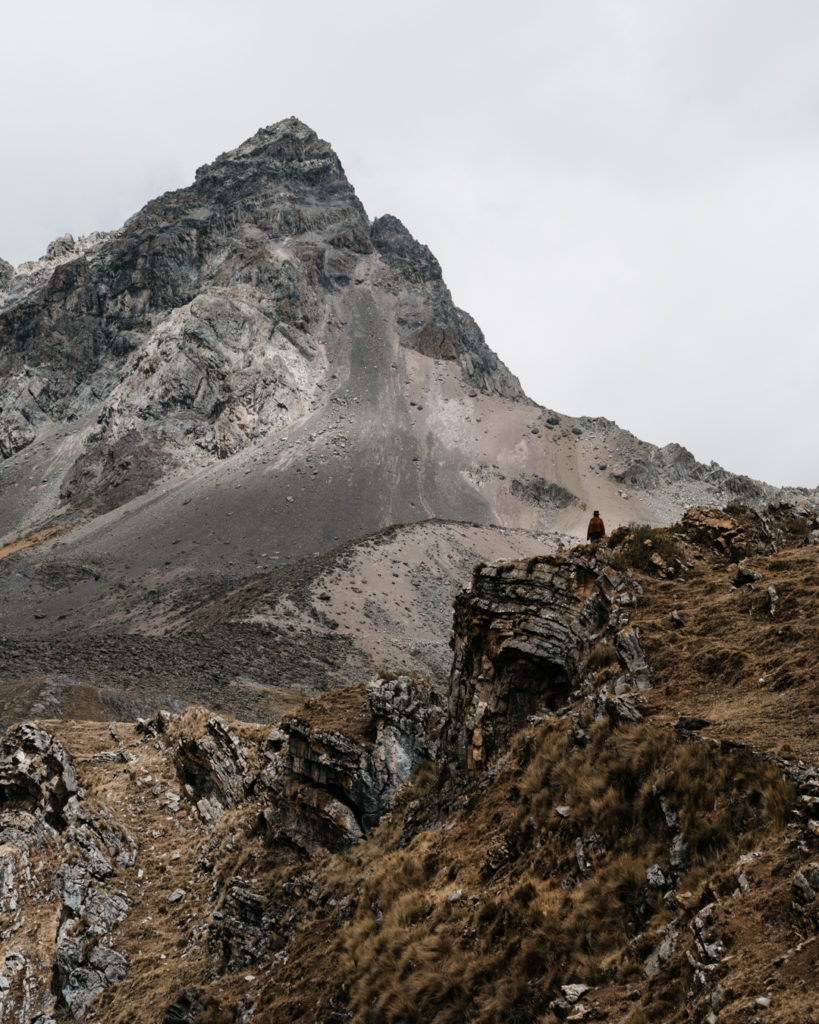
IS HUARAZ A GOOD PLACE FOR SOLO TRAVELERS?
Yes!! Actually as far as outdoor-activity heavy destinations go, it’s a great solo traveler destination! Huaraz is safe, there are many other travelers to meet, and it’s not only easy but standard to join a tour group for most of the hikes. As a solo traveler myself, I met fantastic people on every single hike/trek and also made lots of friends at my hostels.
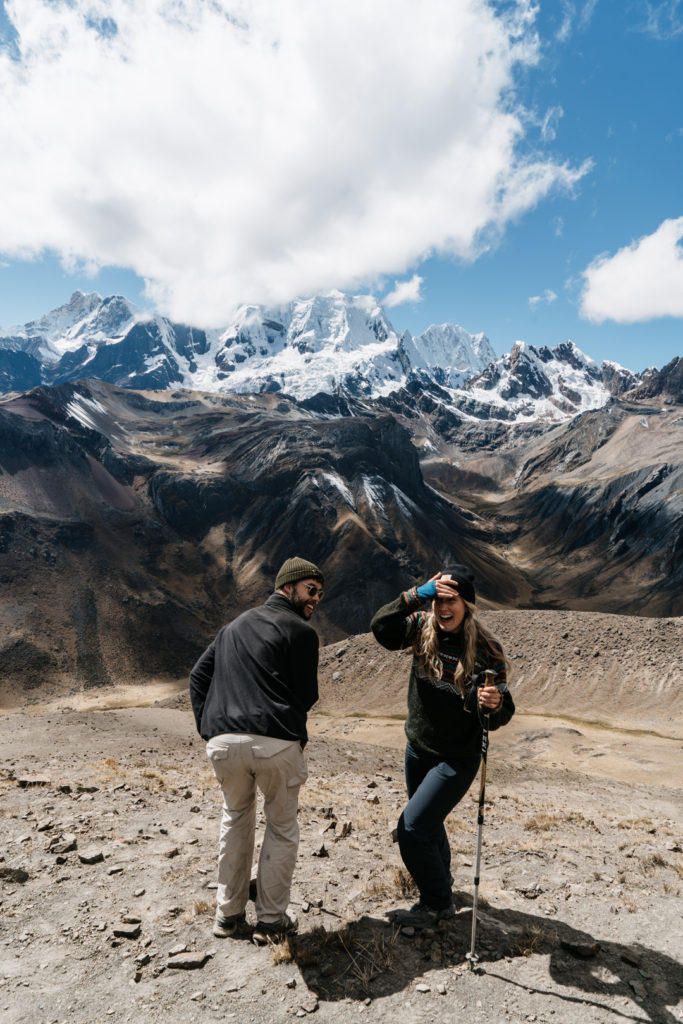
IS HUARAZ SAFE?
The city itself is considered very safe and I personally ran into no issues – not even cat-calling. However, that doesn’t mean you should let your guard down; as always use common sense and be aware of your surroundings. When trekking, especially if on your own, make sure you’re prepared with the right equipment, follow the path and make sure you know the way.
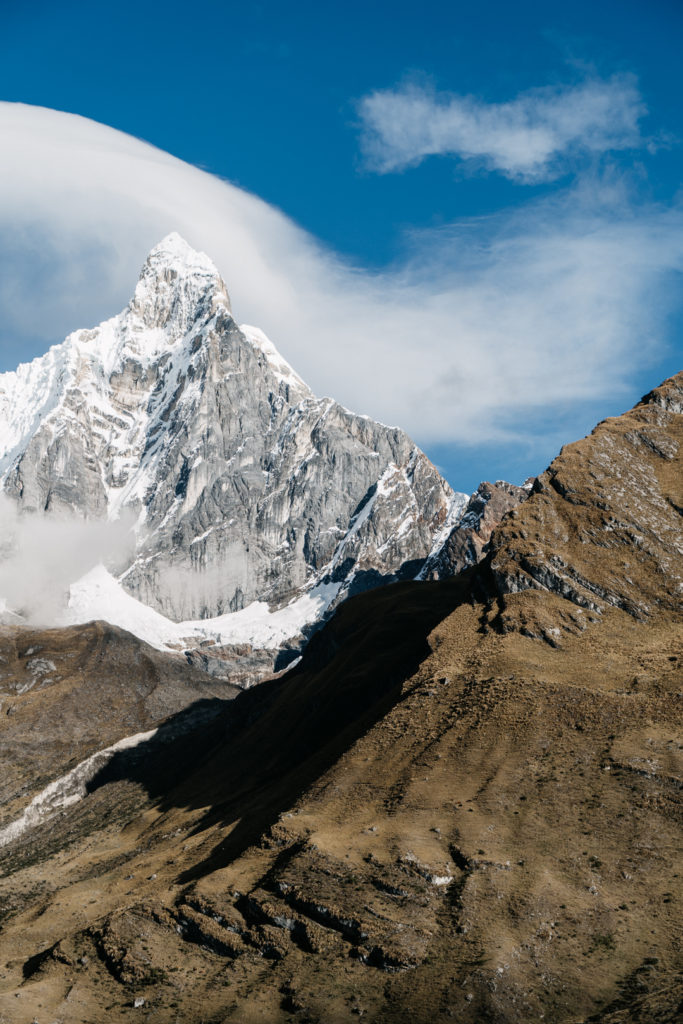
WHAT TO PACK FOR A TRIP TO HUARAZ
Below is a packing list of items I would consider must-haves for Huaraz, Peru:
- Breathable hiking clothes for cold & moderate weather
- Thermal base layers for camping
- Warm top layers for camping
- Sweater, pants, socks (authentic wool from Peru is a good option!)
- Jacket for warmth
- Rain jacket
- Beanie, gloves, neck gaiter
- Baseball cap
- Sunscreen
- Supportive hiking boots
- Hiking socks
- Camp shoes
- Reusable water bottle
- First aid kit
- Altitude medication, imodium, nausea meds, ibuprofen, & electrolytes
- Microfiber towel
- Pillow (for camping)
- Portable charger and/or solar charger (esp. if doing multi-day treks)
- Kindle (a lot of downtime on treks)
- Supportive backpack
- Waterproof backpack covers
- Camera gear to capture the amazing views!
And everything else you would need on your trip such as regular clothes, toiletries, etc.

Travel insurance is always a must, but especially during your trip to Peru where it’s likely you’re doing physical, outdoor activities and have many reservations at risk if any plans change. Injury and cancellations happen, it’s goo to have peace of mind!
My most recommended travel insurance is World Nomads which is designed and made specifically for adventurous backpackers.
However, if you’re on a budget I suggest Safety Wing asa cheaper alternative for just travel medical emergencies.
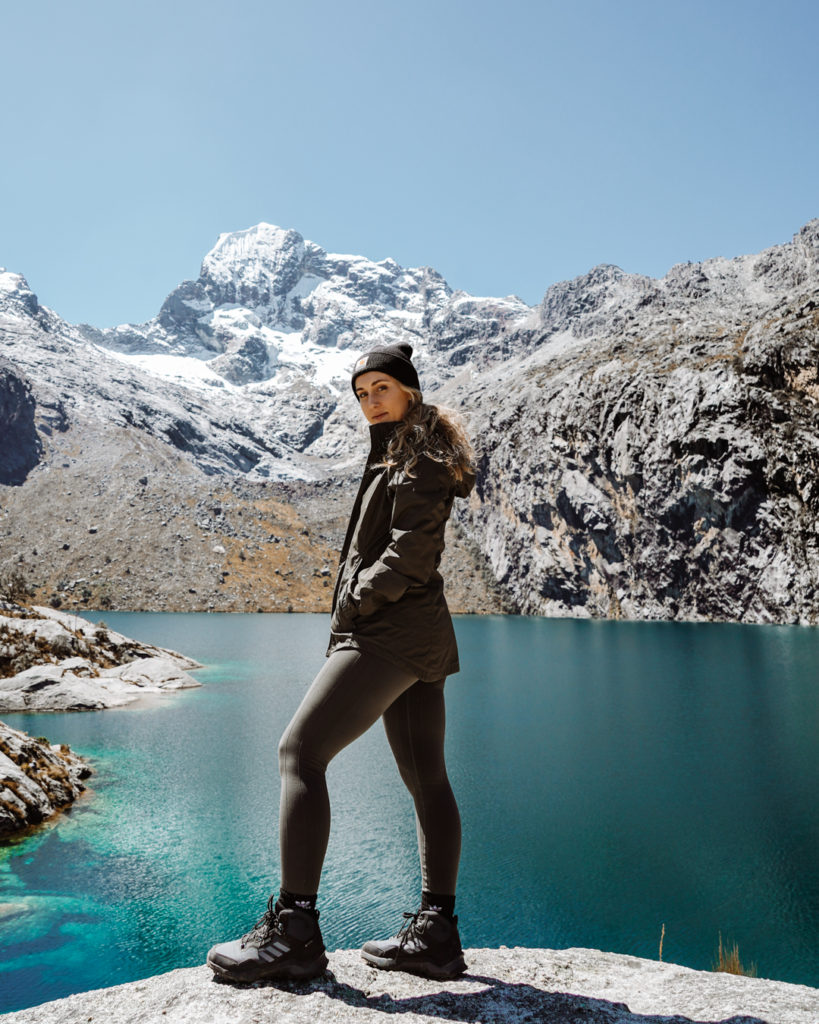
And that concludes my Huaraz guide! I hope you found it helpful and are as hyped as I was to visit this hiking mecca. Get ready to have your mind-blown and have some adventures of a lifetime!
Make sure to pin to save for later, and leave a comment if you enjoyed the post!
Liked this post? Pin it!
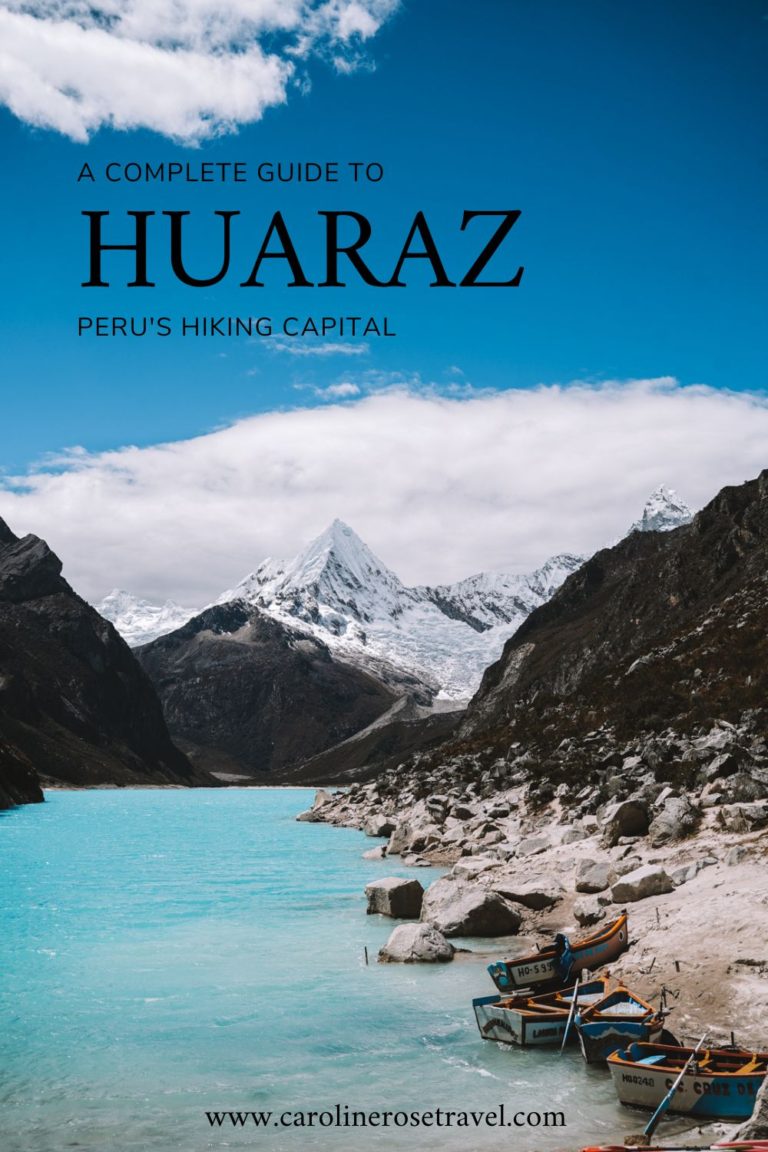
Related posts
-
The Different Ways to Visit Machu Picchu Explained
Visiting Machu Picchu, one of the 7 new wonders of the world, is practically on everyone’s buc...
Destination Guides Peru -
What to Bring Trekking in Peru: An Easy Packing List
On a trip to Peru, it’s likely you’re doing at least one multi-day trek whether it’s the Inca Trail,...
Packing Essentials Peru -
Peru’s Huayhuash Trek: Ultimate Guide by a Solo Female Traveler
Named one of the 10 most beautiful treks in the world, the Cordillera Huayhuash circuit should absol...
Destination Guides Peru




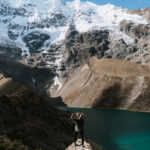
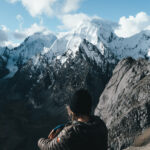
India
Posted at 10:56h, 13 AugustI’ve read some very bad reviews about the gear and the food when doing the Hauyhaush trek with Krystyna Tours I’m a bit nervous to book with them
Caroline Rose
Posted at 22:02h, 20 AugustYou mean Krusty travel? The gear was totally fine in my experience and the food albeit repetitive, was good to me and considering we were remote for 8 days!
Lucinda Ware
Posted at 20:02h, 11 OctoberHi Caroline, my boyfriend and I are in Huaraz now and are trying to decide between Santa Cruz and Huayhuash which is proving incredibly difficult Did you have a clear favourite? Or which would you recommend if you absolutely had to chose one. For reference – we are both pretty fit and enjoy hiking and will be heading to Patagonia later in the year.
Caroline Rose
Posted at 18:50h, 18 NovemberHi Lucina, sorry for the late reply I hope you had an amazing time in Huaraz! For the sake of other’s visiting this blog post, I want to answer this question.
Both Santa Cruz and Huayhuash are beautiful and there’s pros/cons to both. Santa Cruz is shorter, cheaper, and involves more hiking through the valley. It is still a challenge as you’re a high altitude, but the whole trek is kind of working up to one mountain pass and down the other side. I will say, the distances though per day are pretty long even if not always up hill, it’s a lot of walking. But absolutely beautiful!!
Huayhuash on the other hand is 8 days, more expensive, and involves a mountain pass every day and is considered much more challenging, although the days hiking ended earlier than Santa Cruz (shorter distances). I will say the views are absolutely epic, and if this is your deciding factor then I would choose Huayhuash. Not to say Santa Cruz isn’t also beautiful and a really fun trek, but Huayhuash is more iconic in my opinion.
Both have something different to offer though, and I really enjoyed both treks.
Marije
Posted at 01:52h, 20 FebruaryHi Caroline,
Thanks for the informative blog! I am looking into doing the Santa Cruz hike, but will be limited in time so would like to book ahead wherever possible. The bit of information that I cannot find in your blog is if any of the recommended tours provide English speaking guides. As a solo female traveler that doesn’t speak any Spanish this is kind of high on my wish list. Thanks!
Caroline Rose
Posted at 18:19h, 22 FebruaryHi Marije! Many companies provide an English-speaking guide, in fact the company I went through that I recommend here in this post spoke English. Krusty Hostel using Huayhuash Expeditions. I believe the Selina hostel also works with English speaking guides.
zidane
Posted at 11:01h, 26 Decembergreat place to visit, thank you for creating this article
Caroline Rose
Posted at 21:31h, 17 FebruaryGlad you found it helpful!
Pavi
Posted at 03:52h, 12 Aprilhi! thank you so much for writing this – it’s super helpful and informative. Could I ask you how far in advance should I book the Santa Cruz hike with Krusty? I’m going in July and not sure how quickly the tours get booked. I’m also working with a very strict timeline so getting the dates I want is crucial. Did you book the tours only after going to Huaraz?